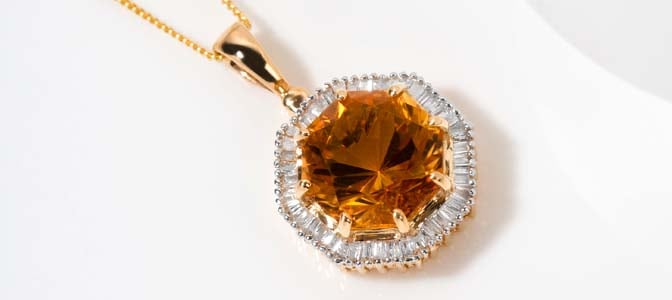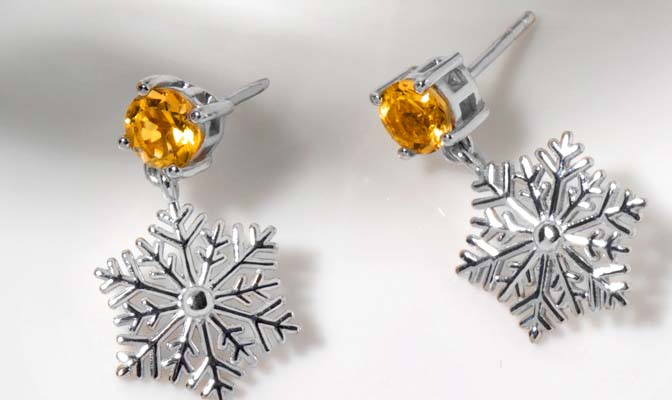Citrine is a sparkling stone display yellow to brownish hues and belong to the yellow variety of quartz. It has also been also called the Merchant stone for its metaphysical properties. Believed to be associated with wealth, prosperity and success.

Introduction
Citrine is a gorgeous yellow gemstone that is widely cherished for its beauty and brilliance. Named after a French word ‘citron’ meaning Lemon, it belongs to a beautiful yellow variety of quartz showcasing glorious gold to warm to red-browns hues, similar to a lemon.
Resembling the coveted gemstone topaz, this gorgeous gemstone is quite desirable in the jewellery industry for its sparkling lustre and stunning hues. It has an eye catchy golden to yellow hue and can be distinguished with its unique sheen. Citrine is associated with the month of November and believed to be a good omen for the thirteenth anniversary.
This robust gemstone comes in a variety of sizes, which offer a good scope for crafting classy jewellery pieces. Interestingly, Queen Victoria loved gemstones, particularly citrine and she had also introduced the embellishment of the stone on kilt pins and brooches. Later, the gemstone was used for decorating a range of things like handles of swords and daggers.
New Arrivals in Citrine

Origin & Supply
This eye catchy gemstone has been mined in Bolivia, Spain, Madagascar, Mexico and Uruguay. The Bolivia Anahi Mine is the main source for the natural citrine, it is a beautiful place with abundance of wildlife. There is an interesting story about the man who first discovered the Bolivia’s Anahí mine in 1600. He attained mine as a dowry when he married to Anahi-the princess from the Ayoreos tribe of Paraguay. It is believed that the mine was closed for the three centuries and opened in the 1960s. Cirtine produced from this mine is typically orange yellow to brownish green yellow.
How Is Citrine Mined?
Citrine belongs to a range of mineral quartz in igneous, metamorphic and sedimentary rocks. The formation of rocks takes place during volcanic eruption which leads to high temperatures, and then these gorgeous forms. The gemstone is mined in Bolivia, Spain, Madagascar, Mexico and Uruguay. Citrine is produced by heat treating the purple Amethyst and also be formed by heat treating smoky quartz. Citrine is affordable and comes in a wide range of shapes and sizes. The stone is ranked 7 on mohs scale, hence it is durable and suitable for large pendants and designer jewellery.

Facts About Citrine
- When a citrine is left in the sunlight, it changes colours.
- Citrine resembles topaz and the colour of citrine is formed magically with chemical reactions.
- Citrine derived its name from a French word Citron meaning lemon.
- Citrine contains silicon dioxide which is found in the human body.
- It shows beautiful pretty pale yellow to gold and red browns hues.
- Most of the Citrine gemstones are found in Brazil and central Africa.
- Citrine promotes creativity and very helpful in eliminating negativity.
- Citrine is associated with the month of November.
- Citrine is also know the Merchant stone as it is associated with wealth and prosperity.
- Citrine is believed to improve health and help with heart and kidney diseases.
- The largest Citrine weights 2258 carats sources from Barzil and displayed at the Smithsonian in Washington.
- Cirtine is also known as ‘Merchant stone’.
- Citirne is a clean stone, it doesn’t contain eye visible inclusions.
- Citrine is counted among the most popular yellow gemstones.
- Citrine is measured at 7 on the mohs scale.
- Citrine is presented on the 13th wedding anniversary and also the stone for the zodiac sign Virgo.
- Saturated yellow to reddish organise is considered finest colours in Citrine.

Properties of Citrine
Citrine is also called as Lemon quartz and forms with the lighter shades of yellow with 7 measurement on the Mohs scale of hardness, hence, Citrine is a durable gemstone. It has a great toughness and is widely desired for the jewellery purposes.
- Colour: Citrine has a wide range colours from lemon yellow to reddish brown. Naturally occurring gemstones are known as Ametrine and they have a magical mix of amethyst and cirtine. Citrine usually comes in golden to yellow hues.
- Cut: The popular cuts associated with Citrine are oval, round and rectangular. Citrine is faceted for the bright the light hues and to enhance its appearance. A fine cut and polished cirtin has an attractive lustre.
- Clarity: Clarity refers to the inclusions present within the gemstone. Citrine has fewer inclusions and most of the cirtine are eye clean. Thus, citrine lack visible inclusions and the best and natural citrne are usually clean. Look at the stone carefully from all angles if you are buying citrine jewellery.
- Carat: Citrine comes in a range of sizes but the value doesn’t increase with the higher prices. Since, Citrine is available in abundance in nature, it has a great demand and the the prices are depends on the rarity of 4c.
Citrine has a mellow soft appeal that attract attention and is ideal for jewellery. The popularity of the stone is increasing as it looks so gorgeous with its sparkling yellow hues and is a great choice for the budget conscious people. The stone is a good alternative for the November birthstone topaz, it looks classy, delightful and has been skilfully faceted for the enhancement of the hues.

What to remember while buying Citrine?
- Citrine is stone of vivid yellow colour. It gets its fame from its deeply pigmented hues. The first thing you need to know is that if it’s not yellow, its’ not citrine.
- Another close attribute of citrine gemstone is that it has slight reddish hues when you look at it closely.
- More popular cuts of this gem are that bring out its clarity in depth, so always pick oval, round, trillion, et cetera. Cabochon cut is also found, but it considered to be quire rare.
- Always confirm if your citrine gem has undergone any treatment. Most gemstones go under heat treatment to bring out their colour. That said, citrine is a very clear stone and shouldn’t undergo any other treatment than for its colour.
- It is important to note that citrine isn’t always available in a larger size. It’s a stone found small in nature. So, if yours is a big stone without having to pay a large amount, there’s a good chance that it’s colour-treated amethyst.
- Citrine rates only 7 on the Mohs Scale of Hardness, which means that it’s a rather soft stone. It can easily get scratched and cracked on bumps and abrasions.
- Hold your piece of citrine against the light before making your purchase. If you see air bubbles and heavy presence of inclusions, then it isn’t citrine. Citrine gemstone is naturally free of inclusions.
FAQ's
What does citrine gemstone mean?
What does Citrine symbolize?
Citrine is a gorgeous yellow stone that has been valued for its brilliance since ancient times. Also known as the stone of the sun, this stunning gemstone often represent healthy mind and body.
What is my birthstone for November?
Citrine and Topaz are believed to be associated with the month of November. This sunny hue stone is believed to a healing stone and display variety of yellow hues.
Is citrine quartz the same as citrine?
Pale yellow citrine rare and are only found in nature. Citrine is the most preferred semi-precious after blue topaz and widely cherished for its gorgeous yellow colour similar to lemon. Madeira Citrine is famous for its stunning golden yellow colours and has a higher value.
What colour Citrine is most valuable?
Pale yellow citrine rare and are only found in nature. Citrine is the most preferred semi-precious after blue topaz and widely cherished for its gorgeous yellow colour similar to lemon. Madeira Citrine is famous for its stunning golden yellow colours and has a higher value.
Is Natural Citrine expensive?
Natural citrine are rare, usually comes in lighter honey to white hues. The production of citrine is not very high, hence, all types of citrine are relatively rare so it can be costly.
How is citrine created?
Most citrine are heat treating Purple Amethyst and also formed by treating smoky quartz. In some deposits, Citrine is partially or completely transformed into a yellow citrine due to a natural heating process.
Why is citrine is so rare?
Natural citrine is quite rare as it is valuable than other varieties of quartz. Since, most citrine are heat treated, it gives an amazing golden colour though all types of citrine are rare.
Where is Citrine commonly found?
This beautiful stone is mined in Bolivia, Spain, Madagascar, Mexico and Uruguay. Bolivia is the mail source for this gemstone.
Does citrine break easily?
Citrine has an amazing toughness, it doesn’t chip or break easily. If citrine is carefully treated, it is long lasting. Citrine are ideal for pendants and earrings. Not very best for the rings or bracelets.







































